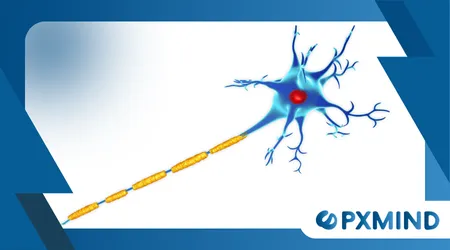The Role of Myelin in Learning and Speed

Role of Myelin in Learning and Speed. The secret to mastering a new skill, whether it’s playing the piano or acing a complex coding language, lies buried deep within the architecture of our brains.
Anúncios
Specifically, we are talking about a fatty, protective substance: myelin.
This sheath is not merely insulation; it’s the master key to neural efficiency and, consequently, our capacity for rapid learning.
What Exactly Is Myelin, and How Does It Function Role of Myelin in Learning and Speed?
Myelin is a lipid-rich membrane wrapped tightly around the axons of many neurons. Think of it as the electrical tape insulating a crucial wire.
This insulation is absolutely vital for the nervous system’s function.
This jumping mechanism, known as saltatory conduction, dramatically boosts the rate of signal transmission.
The result is a lightning-fast, highly efficient communication network within your brain.
Why Is Myelin Formation the Engine of Skill Acquisition?
Learning is fundamentally about forging and strengthening specific neural circuits.
When you repeatedly practice a task, those particular neurons fire together consistently. This repetition signals the brain to invest resources in those pathways.
The brain’s investment takes the form of myelination, the process where specialized cells—oligodendrocytes in the central nervous system—create the myelin sheath.
Increased practice equals thicker, more robust myelin.
Thicker myelin leads to faster, more precise signal transmission.
This improved efficiency is what translates directly into increased speed and automaticity when performing the skill.
How Does Myelin Impact the Speed of Cognitive and Motor Tasks?
The difference between a novice and an expert often boils down to the Role of Myelin in Learning and Speed.
Consider the classic example of a virtuoso guitarist executing a complex solo. Their fingers move with impossible speed and accuracy.
This isn’t just muscle memory. It’s the result of highly myelinated pathways connecting their motor cortex to their hand muscles.
The neural command travels from the brain to the fingers almost instantaneously.
In cognitive tasks, the principle holds true. Rapid recall, quick problem-solving, and efficient decision-making all rely on well-insulated, high-speed neural circuitry.
Can you truly have speed without efficiency?

What Is the Evidence for Myelin’s Role in Human Performance?
Scientific research strongly supports the link between myelin integrity and high performance.
A 2014 study published in the journal Science provided compelling evidence.
Researchers used diffusion tensor imaging (DTI) to study the white matter microstructure of professional pianists.
Read here: Can Brain Training Games Really Improve Your Mind?
They found a significant correlation: the higher the skill level, the greater the white matter (myelin) integrity in the tracts connecting motor and auditory processing centers.
This physical change is the anatomical signature of expertise.
This finding underscores that skill development is not purely synaptic; it is also a process of physical insulation and structural reinforcement.
The brain literally rebuilds its wiring for optimization.
How Can We Actively Promote Myelination for Better Learning?
Since myelination is an experience-dependent process, the quality of your practice is paramount.
Simply repeating a task mindlessly won’t suffice. Deep, deliberate practice is the key activator.
This involves focusing intently on the specific area of challenge, the so-called “sweet spot” just outside your current comfort zone.
Check this out: What Neuroscience Says About Creativity
This targeted effort sends the strongest “construct myelin here” signals.
Another factor is sleep. During deep sleep, the brain is thought to consolidate memories and is highly active in the myelin-building process.
This emphasizes that rest is not passive; it is an active stage of learning.
A single, important statistic drives this home: in the central nervous system, a single oligodendrocyte can myelinate up to 50 different axons.
This high capacity means that when the system is activated, improvement can be widespread.
Why Is Consistent, Focused Effort the True Accelerator?
Many people believe they simply lack the “natural talent” for a skill.
While initial genetic variation exists, the plasticity of the myelin sheath offers a powerful counter-argument. You are not stuck with your starting brain.
Your deliberate effort, consistently applied, literally rewrites your brain’s structure.
++ Grounding Exercises for Everyday Stress
Imagine learning to speak a second language. At first, translating is slow and requires immense effort.
Over time, with consistent immersion and practice, the thought process transitions directly to the second language.
The neural pathway has thickened, allowing the thought to flow Role of Myelin in Learning and Speed and effortlessly. This is the structural reality of fluency.

The Future Implications of Understanding the Role of Myelin in Learning and Speed
Understanding this biological mechanism opens doors for optimizing education and rehabilitation.
Future training programs will likely be designed to maximize the factors known to induce rapid, targeted myelination.
For instance, in physical rehabilitation after a stroke, focused, high-repetition, and progressively challenging movements are key.
This is the behavioral manifestation of the brain’s demand for increased Role of Myelin in Learning and Speed in the damaged pathways.
Our final example involves a professional gamer practicing a specific, highly demanding micro-movement sequence.
They repeat it thousands of times, generating the structural change that provides the necessary milliseconds of speed advantage.
The final mastery is a testimony to the Role of Myelin in Learning and Speed.
The Role of Myelin in Learning and Speed is clear: it’s the neural highway that dictates how fast we go.
By practicing with purpose, we are not just improving our skills; we are physically building a faster, smarter brain.
| Myelin Impact Factor | Mechanism of Action | Observable Outcome in Skill |
| Deliberate Practice | Signals Oligodendrocytes for Sheath Production | Increased Automaticity and Precision |
| Saltatory Conduction | Signal Jumps between Nodes of Ranvier | 100x Increase in Signal Transmission Speed |
| Cognitive Load Reduction | Efficient Circuits Require Less Effort | Faster Decision-Making and Recall |
Myelin – The Unsung Hero of High Performance
The fatty sheath we call myelin is truly the unsung hero behind human expertise.
From the athlete’s reflexes to the mathematician’s quick calculations, the underlying mechanism is the same: faster, more robust signal transmission.
Understanding the Role of Myelin in Learning and Speed empowers us to train smarter, rest better, and unlock our absolute cognitive potential.
Frequently Asked Questions
Can Myelin be repaired or regenerated in adults?
Yes. While myelin was once thought to be static, current neuroscience confirms the adult brain maintains a capacity for myelin plasticity and repair, particularly in response to focused learning, exercise, and certain cellular signals.
This ongoing process is why adults can continue to master new skills.
Does Myelin affect intelligence (IQ)?
Myelin does not cause general intelligence, but it is critically important for it.
Higher IQ scores often correlate with better-connected and faster processing throughout the brain, which is directly facilitated by myelination.
It improves the efficiency of information processing, which is a component of intelligence.
